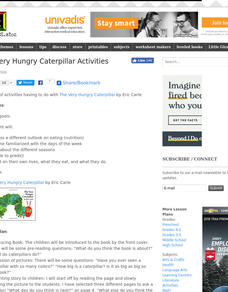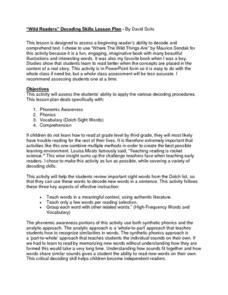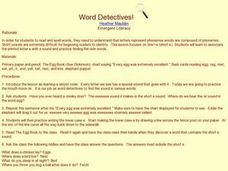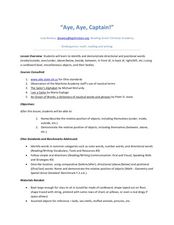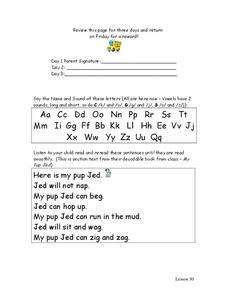Curated OER
The Very Hungry Caterpillar
Students participate in activities associated with the book, "The Very Hungry Caterpillar". They practice using new vocabulary and the days of the week. They create a book about what they ate on the different days of the week and how the...
Alabama Learning Exchange
Phonics lesson for -ick family
Kindergarteners and first graders develop phonemic awareness for words that contain -ick. Each learner gets a stack of cards with different -ick words, highlighting the target sound as they review each one.
Curated OER
The Hole Story
In this filling in the blanks and sequencing learning exercise, learners use words from the word box to complete the sentences and number the pictures to show the order of events in the short story. Learners write 8 answers.
David Suits
“Wild Readers” Decoding Skills Lesson Plan
Set young readers on the path toward fluency with this phonemic awareness resource. Based on the award-winning children's book, Where the Wild Things Are, this lesson allows beginning readers to practice isolating phonemes and...
Curated OER
A? Speak up, I can't hear you!
Students become phonemically aware of various sounds that make up written words. This lesson focuses on the vowel correspondence a_e=/A/. They decode the long a mouth moves in words as well as practice spelling the words themselves.
Curated OER
Icky Icky I
First graders review the letter "i" and use popsicle sticks and cotton balls to make upper and lower case "i's". Volunteers make the capital and lower case "i" on the board and then the class discovers the short sound that letter "i"...
Curated OER
Itchy Iggy
First graders observe the letter /i/ and the sound that it makes watching their mouths as the sound is formed. They say the tongue twister displayed repeating it three times; the last time they stretch out the /i/ sound as it occurs in...
Curated OER
The Letter O
In this letter O worksheet, learners determine whether an underlined word had the long or short o sound, circling the correct answer.
Pennsylvania Department of Education
What's My Sound?
Students follow a power point presentation to practice the sounds each letter of the alphabet make. In this 'what's my sound' activity, students apply word recognition strategies and demonstrate listening and comprehension skills to...
Curated OER
Vowel Change of Short E
In this language arts worksheet, students look for the pattern for changing the vowel "E" into the right form for writing the words in the Latin language.
Florida Center for Reading Research
Picture the Word
This is an excellent way to make onset and rime visual for beginning readers. They examine CVC-word picture cards that are all missing the first letter. Using plastic letters (or whatever you have), they complete each word and record it...
Curated OER
Voicing and Syllable Length (Using Rubber Bands)
Students identify voiced and unvoiced sounds. They practice using short and long vowel sounds. They identify consonants only after paying attention to the length of vowels. They use rubber bands to help them determine the difference...
Curated OER
Word Detectives!
Students recognize the short vowel e in written and spoken language. Through matching activities, students discriminate the short vowel e from the long vowel o. They associate the phoneme with its letter representation and identify the...
Curated OER
Appetizing Apples
Pupils recognize the short vowel a in written and spoken language. Through matching activities, students discriminate the short vowel a from the long vowel a. They associate the phoneme with its letter representation and identify the...
Curated OER
Iggy and the Icky Sticky Inchworm
Students read and spell words. They have to recognize that letters stand for phonemes and spellings map out spoken words. Long and short vowels are hard to recognize and this lesson focuses on that. The short i is taught in the...
Curated OER
Doctor Check-Up
Students recognize the short vowel o in written and spoken language. Through matching activities, students discriminate the short vowel o from the long vowel o. They associate the phoneme with its letter representation and identify the...
Curated OER
Aye, Aye Captain
Learners investigate how correspondences appear differently in different words. They also recognize the difference between long and short vowels. Students study how these correspondences are spelled and pronounced differently.
Curated OER
Open Wide
Students recognize the short vowel o in written and spoken language. Through matching activities, students discriminate the short vowel o from the long vowel o. They associate the phoneme with its letter representation and identify the...
Curated OER
Phonics lesson for -ar
First graders identify words associated with the -ar sound. They read sentences and compose a story that include words with the -ar sound. The assessment portion of lesson plan involves students in spelling words with the
-ar pattern.
Curated OER
IIII---L-lll-ke---IIII-ke-and-M-IIII-ke
Learners recognize the letter combination i_e by reading and spelling words with letter boxes in this lesson. They say a tongue twister which emphasizes the long /i/ silent /e/ combination. They then listen the story "Kite Day at Pine...
Curated OER
Trucks and Community Workers
First graders identify community helpers and their roles. In this transportation lesson, 1st graders complete a series of lessons integrating technology and literacy. Students decode sounds of short u, c/s/ and g/j/ words and improve...
Curated OER
"Ca...Ca...Ca...Caterpillar Blending"
Students improve blending skills. They produce many individual short utterances and mouth moves (phonemes) into one long utterance (words) and create their own blending caterpillar. They draw a picture of a caterpillar with three...
Curated OER
Word and Letter Practice #6
In this word and letter practice worksheet, students say the name and sounds of given letters, read simple sentences, practice reading sight words and practice "chunks" of words.
Curated OER
Words and Letters Practice #3
In this words and letters practice learning exercise, students practice naming letters and practicing sounds of given sets of letters, read simple sentences, and practice sight words.


